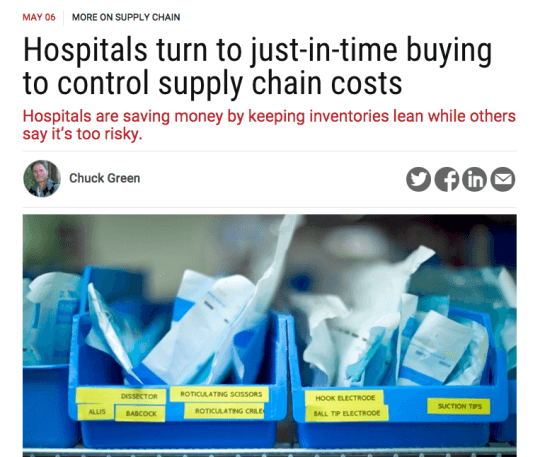
The Wall St Journal loves writing about how “Just In Time” (JIT) is a risky inventory strategy. See my past posts about how the WSJ is so often wrong on this.
The WSJ seem to only understand Lean as JIT, as opposed to seeing Lean as a broader methodology and management system. JIT is just one component of the Toyota Production System (built-in quality being the other). See Toyota's website for info straight from the source.
Whenever there is a highly unusual event, like the Japanese earthquake and tsunami, the WSJ will say “see, just in time doesn't work.” Well, keeping a lot of inventory stored in a warehouse isn't a good strategy if an earthquake or tornado hits the warehouse.
The Stanley Cup Was Late!
Even though I'm a Detroit Red Wings fan, I can say congrats to the Chicago Blackhawks for winning the Stanley Cup Finals in the NHL. Chicago was ahead in the series three games to two, meaning they were in a position to put the series away last Monday night, playing at home.
Listen to Mark read the post (subscribe to the audio series):
The Stanley Cup is possibly the most famous trophy in sports. Hockey fans are used to the iconic scene of players holding the Cup over their heads after winning the championship (such as these Red Wings have done). The Cup has a team of handlers who guard, transport, and polish the trophy.
Just In Time inventory strategies always require some amount of “safety stock” inventory in case something goes wrong. In a factory or a hospital, a JIT system, like a “Kanban” system, could have things go wrong, such as:
- A delivery is late
- A delivery has some defective items in it
- Usage was higher than expected
It's irresponsible to think everything will always go perfectly. Murphy's Law and all that… you have to plan for variation, although you might not plan for that extremely rare earthquake event.
Last week, the Stanley Cup was brought to the arena LATE. It wasn't there by the end of the game. Players and fans had to WAIT to celebrate. Ah, the waste of waiting.
See this article: Stanley Cup late arriving to Chicago Blackhawks' party thanks to rainstorm
Maybe the headline should have read “Stanley Cup late arriving to Chicago Blackhawks' party thanks to poor planning.”
“… when the final buzzer sounded, the Stanley Cup itself was not yet in the United Center.
Instead, severe rainstorms left many streets in Chicago flooded and traffic snarled throughout the city, preventing the historic trophy from getting to the arena on time.”
There were extremely bad storms in the Chicago area. I know because I was trying to fly there and I had two flights canceled and I got there seven hours later than planned. But, when traveling for a client, I make sure to build in “buffer time.” I try to never schedule the last flight of the day, in case something goes wrong. It's better to arrive a little early than it is to cut things close and risk being late.
The Stanley Cup handlers didn't think the same way.
Supposedly, they started driving the Cup toward the arena when the puck dropped at the start of the game. That would have normally given them 2.5 hours. Why was the Cup being kept at a suburban hotel? Why wasn't it brought to the arena the morning of the game?
Being late led to the use of a police escort (which costs the area taxpayers money) and they drove at speeds of over 100 miles per hour.
The Wall St Journal would have explained the lateness of the Stanley Cup as proof that “Just In Time” doesn't work. Nah, they just didn't plan properly. They didn't leave in enough buffer time or “safety stock” time. That delay should have never occurred – the players and fans shouldn't have been kept waiting.
Risk For Hospitals?
I've helped many hospitals put Kanban systems into place. We always plan carefully and make sure we have “a little too much” inventory rather than “not quite enough.” The cost of extra inventory is less of a problem than running out of a supply or item that's needed for patient care. We don't want a patient to die because we were being cheap on inventory. The first goal is patient care… the second goal is avoiding excessive inventory cost.
See this recent video that I shared about a hospital's Kanban system.
This article from Healthcare Finance News brings up the issue of risks of JIT… or I'd say the risk of not doing JIT or Kanban properly. Is it “too risky?”

Controlling costs is a goal… but the headline should be about making sure staff and patients have what they need. I think reducing stockouts is the more important goal. Hospital supply chains and material management systems are usually pretty broken.
From the article:
“If you carry inventories under JIT that are so low that the product's unavailable because of one incidence, that can be hugely adverse in the hospital sector,” he said.
Exactly — that's why you have to do Kanban and JIT properly. Don't be like the Stanley Cup team…
And from a man with the appropriate last name of “Stanley:”
As for Stanley, he doesn't buy the notion that just because it's healthcare, running a lean operation is too risky.
“Anyone, in any industry, can use that excuse.”
Agreed.
What do you think? Please scroll down (or click) to post a comment. Or please share the post with your thoughts on LinkedIn – and follow me or connect with me there.
Did you like this post? Make sure you don't miss a post or podcast — Subscribe to get notified about posts via email daily or weekly.
Check out my latest book, The Mistakes That Make Us: Cultivating a Culture of Learning and Innovation:










It was puzzling that they didn’t have the Cup at the arena. Maybe the Cup Keepers (or whatever they’re called) couldn’t get a hotel room?